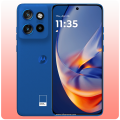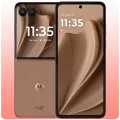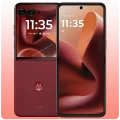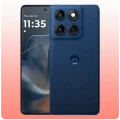- Home
- All Products
- Mobiles
- Motorola Razr 60
Motorola Razr 60





-
CPU: MediaTek Dimensity 7400X (4 nm)
-
RAM: 8GB
-
Storage: 256GB (UFS 2.2)
-
Display: 6.9 inches, Foldable LTPO AMOLED, 120Hz
-
Main Camera: 50 MP (wide) + 13 MP (ultrawide)
-
Selfie Camera: 32 MP
-
Battery: 4500 mAh
-
OS: Android 15
Overview
General
| Device Type | Smart Phone |
| Announced | 24-04-2025 |
| Released | 25-04-2025 |
| Status | Available |
| International Price | $1,399 |
| Indian Price | ₹99,999 |
| BD Unofficial Price | ৳130,000 |
Design
| Type Design Type called form factor refers to a mobile phone's size, shape, and style as well as the layout and position of major components of phone. There are three major form factors seen in mobile phones => bar phones, folding phones and sliding phones. | Bar |
| Dimensions | Unfolded: 171.3 x 74 x 7.3 mm and Folded: 88.1 x 74 x 15.9 mm |
| Weight | 188 g (6.63 oz) |
| Body Thickness | 7.3 mm (unfolded) |
| Protection | Plastic front (unfolded), Gorilla Glass Victus (folded), eco-leather back, aluminum frame (6000 series), stainless steel hinge |
| Colors | Gibraltar Sea, Spring Bud, Lightest Sky, Parfait Pink (Pantone Colors) |
| Water Resistant | IP48 dust and water resistant (up to 1.5m for 30 min) |
Network
| Technology | GSM / CDMA / HSPA / EVDO / LTE / 5G |
| SIM | Nano-SIM + eSIM / Nano-SIM + Nano-SIM |
| Speed | HSPA, LTE (CA), 5G |
Display
| Display Type Display Technology => A number of display technologies and types used in mobile phones => TFT (Thin Film Transistor), IPS (In-Place Switching), OLED (Organic Light Emitting Diode), AMOLED (Active-Matrix Organic Light-Emitting Diode), Super AMOLED (an even advanced version of AMOLED), Resistive Touchscreen (Resistive touchscreens contain two layer of conductive material with a very small gap between them which acts as a resistance), Capacitive Touchsceen (Capacitive touchscreen technology consists of a layer of glass coated with a transparent conductor) | Foldable LTPO AMOLED, HDR10+ |
| Size | 6.9 inches, 107.6 cm² (~84.9% screen-to-body ratio) |
| Resolution | 1080 x 2640 pixels (~413 ppi) |
| Display Colors Display Colors is refers to the number of different shades of colors that the screen is capable of displaying => 64K colors, 256K colors and 16 million colors, Obviously 16M is highest available range of colors and better than others. | 1B colors |
| Refresh Rate | 120Hz |
| Display Brightness | 3000 nits (peak) |
| Secondary Display |
AMOLED, 1B colors, 90Hz, HDR10+ Size: 3.6 inches Resolution: 1056 x 1066 pixels (~413 ppi) Protection: Corning Gorilla Glass Victus |
Main Camera
| Camera 1 Camera is able to capture photographs and usually videos, The most important characteristics of a camera are the resolution (measured in megapixels), lens focus type (fixed or automatic), higher megapixel cameras are known to capture higher quality photos, but not always a good measurement of the photos quality. | 50 MP, f/1.7, (wide), 1/1.95", 0.8µm, dual pixel PDAF, OIS |
| Camera 2 | 13 MP, f/2.2, 120˚ (ultrawide), 1/3.0", 1.12µm, AF |
| Video | 4K@30fps, 1080p@30/60fps, gyro-EIS |
| Camera Features | LED flash, panorama, HDR, Pantone Validated Colour and Skin Tones |
Selfie Camera
| Camera 1 Camera is able to capture photographs and usually videos, The most important characteristics of a camera are the resolution (measured in megapixels), lens focus type (fixed or automatic), higher megapixel cameras are known to capture higher quality photos, but not always a good measurement of the photos quality. | 32 MP, f/2.4, (wide), 1/3.14", 0.7µm |
| Video | 4K@30fps, 1080p@30/60fps |
| Camera Features | HDR |
Software
| Operating System OS => Every computer system run on a base software called Operating System (OS). Operating System controls all basic operations of the computer (such as smartphone, PDAs, tablet computers and other handheld devices). The Operating System allows the user to install and run third party applications (apps), apps are used to add new functionality to the device. | Android 15 |
Hardware
| Chipset Chipset is a group of integrated circuits designed to perform one or a more dedicated functions, often with real time computing constraints, Popular smartphones are equipped with more advanced embedded chipsets that can do many different tasks depending on their programming. | MediaTek Dimensity 7400X (4 nm) |
| GPU GPU (Graphics Processing Unit) is a single-chip processor designed to rapidly manipulate and alter memory to accelerate the creation of images in a frame buffer intended for output to a display, This includes things such as lighting effects, object transformations, and 3D motion. | Mali-G615 MC2 |
| RAM (Memory) RAM (Random Access Memory) is a type of computer memory that can be accessed randomly, any byte of memory can be accessed without touching the preceding bytes that allows information to be stored and accessed quickly from random locations. RAM is the most common type of memory found in computer systems, smartphones, tablets and other electronic devices. | 8GB |
| Internal Storage Internal Storage is a data storage space (flash memory) mostly used in smartphones, tablets and other electronic devices where operating system, apps, music, photos, videos, files and other user data Is stored. | 256GB |
| Storage Technology | (UFS 2.2) |
| Card Slot Memory Card Slot is a special slot for inserting a memory card. Memory cards allow you to expand the phone's built-in memory, A memory card (sometimes called a flash memory card or a storage card) is a small storage medium used to store data such as text, pictures, audio, and video, for use on small, portable or remote computing devices such as mobile phones, mp3 players, digital cameras. | No |
| Sensors Sensors are electronic components that detects and responds to some type of input from the physical environment. The specific input could be light, heat, motion, moisture, pressure and location, The output is generally a signal that is converted to use in computing systems, a location sensor, such as a GPS receiver is able to detect current location of your electronic device. |
Fingerprint (side-mounted), accelerometer, gyro, proximity, compass |
Connectivity
| Bluetooth Bluetooth is a wireless communications technology for exchanging data between mobile phones, headsets, computers and other network devices over short distances without wires, Bluetooth technology was primarily designed to support simple wireless networking of personal consumer devices. | 5.4, A2DP, LE |
| Wi-fi Wi-Fi is a popular wireless networking technology using radio waves to provide high-speed network connections that allows devices to communicate without cords or cables, Wi-Fi is increasingly becoming the preferred mode of internet connectivity all over the world. | Wi-Fi 802.11 a/b/g/n/ac/6 or 6e, dual/tri-band (region dependent) |
| USB | USB Type-C 2.0 |
| Placement GPS The Global Positioning System is a satellite-based radio navigation system, GPS permits users to determine their position, velocity and the time 24 hours a day, in all weather, anywhere in the world, In order to locate your position, your device or GPS receiver must have a clear view of the sky. | GPS, GLONASS, GALILEO, BDS, QZSS |
| NFC NFC (Near field communication) is a set of standards for smartphones and similar devices to establish peer-to-peer radio communications with each other by touching them together or bringing them into proximity, usually no more than a few inches. | Yes |
| Wireless Charging Wireless Charging (Inductive Charging) uses an electromagnetic field to transfer energy between two objects. This is usually done with a charging station. Energy is sent through an inductive coupling to an electrical device, which can then use that energy to charge batteries or run the device. |
Sound
| Loudspeaker | Yes, with stereo speakers (Dolby Atmos) |
| Headphone Jack |
Battery
| Battery Type Battery Type => Cell phones run on various kinds of batteries depending on the manufacturer, phone size or shape and features. There are basically four types of cell phone batteries => Lithium Polymer, Lithium Ion, Nickel Metal Hydride and Nickel Cadmium. | Si-Ca (Silicon Carbide) |
| Capacity Battery Capacity is a measure (typically in Amp-hr) of the charge stored by the battery, and is determined by the mass of active material contained in the battery. The battery capacity represents the maximum amount of energy that can be extracted from the battery under certain conditions. | 4500 mAh |
| Charging |
30W wired 15W wireless |
Performance Tests
| AnTuTu | 1,865,776 |
| GeekBench |
Single-Core: 2,936 Multi-Core: 8,883 |
Overall Review
The Motorola Razr 60 is a stylish and feature-rich foldable smartphone that combines modern aesthetics with powerful performance. Launched in April 2025, it offers a compelling package for users seeking innovation and practicality.
📱 Motorola Razr 60 – Key Specifications
- Main Display: 6.96-inch Full HD+ pOLED LTPO screen, 120Hz refresh rate, HDR10+, 3,000 nits peak brightness
- Cover Display: 3.63-inch pOLED screen, 90Hz refresh rate, HDR10, 1,700 nits peak brightness, protected by Gorilla Glass Victus
- Processor: MediaTek Dimensity 7400X (4nm)
- RAM & Storage: Up to 8GB RAM and up to 256GB UFS 2.2 storage
- Rear Cameras:
- 50MP main sensor with f/1.8 aperture and OIS
- 13MP ultra-wide-angle lens with macro mode support
- Front Camera: 32MP sensor for high-quality selfies and video calls
- Battery: 4,500mAh capacity with 30W TurboPower wired charging and 15W wireless charging
- Operating System: Android 15
- Build & Design: IP48-rated for water and dust resistance; available in Pantone colors like Gibraltar Sea, Spring Bud, and Lightest Sky
- Connectivity: 5G, Wi-Fi 6E, Bluetooth 5.4, NFC, USB Type-C
- Security: Side-mounted fingerprint sensor
✅ Pros
- Innovative Foldable Design: Combines a large internal display with a functional external screen, enhancing multitasking and usability.
- Powerful Performance: The Dimensity 7400X chipset ensures smooth operation and efficient multitasking.
- Versatile Camera System: High-resolution sensors with features like OIS and macro mode cater to diverse photography needs.
- Robust Battery Life: The 4,500mAh battery supports fast charging options, ensuring minimal downtime.
- Enhanced Durability: IP48 rating and Gorilla Glass Victus protection add resilience to daily wear and tear.
⚠️ Cons
- No Expandable Storage: Lacks a microSD card slot, limiting storage expansion options.
- No 3.5mm Headphone Jack: Users need to rely on wireless or USB-C audio solutions.
- Limited Availability: As of now, the device is primarily available in select markets.
📌 Final Verdict
The Motorola Razr 60 stands out in the foldable smartphone segment with its sleek design, powerful performance, and versatile camera system. While it has some limitations, such as the absence of expandable storage and a headphone jack, its overall feature set offers excellent value for users seeking a premium and innovative smartphone experience.
Disclaimer Note
Disclaimer: Prices listed are for reference only and may vary. We strive to keep information up to date but cannot guarantee accuracy. Please verify with the retailer before making a purchase.






